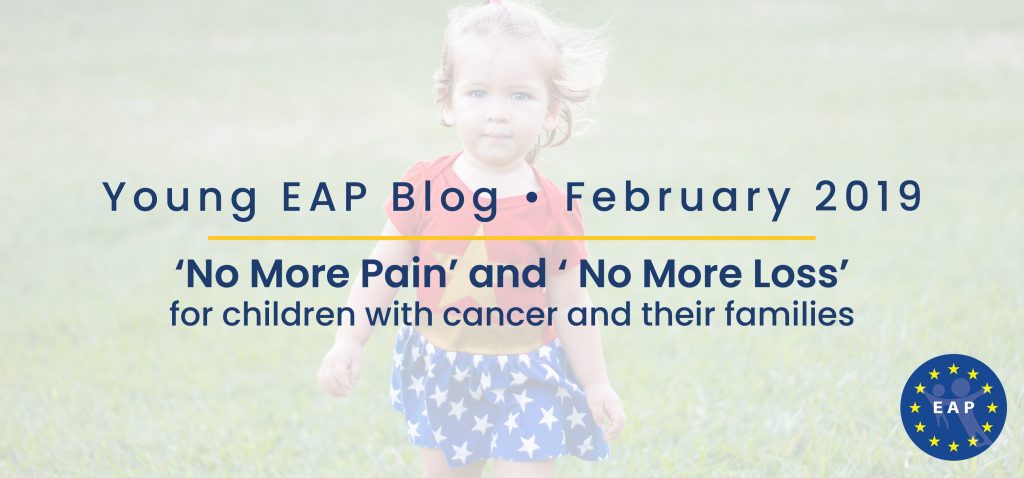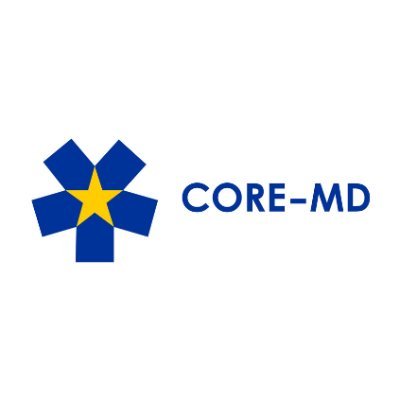YOUNG EAP BLOG | ‘NO MORE PAIN’ AND ‘NO MORE LOSS’ FOR CHILDREN WITH CANCER AND THEIR FAMILIES
February 11, 2019

THE SITUATION
Globally, a child dies of cancer every 3 minutes. Every year in Europe, more than 6,000 children and young people die from cancer and more than 35,000 are diagnosed with the disease..
Cancer incidence in children and young people (adolescents and young adults) in Europe has increased over the past two decades and cancer remains the leading cause of disease-related death in children aged one or over. Despite this, the needs of children and young people with cancer are not sufficiently taken into account into European and national policy initiatives.
HOW DOES THIS AFFECT YOUNG PEOPLE WITH CANCER IN EUROPE?
Children and young people with cancer face several unique challenges.
Quality care and early diagnosis increase the chance of survival
Not all children with cancer in Europe have equal access to standard care, expertise, and research. Compared to other European regions, five-year survival is 10-20% lower in Eastern Europe – and this gap may be even larger in countries where cancer survival is not measured at a population level. The majority of these disparities are due to the different treatment approaches, the organisation of care, and the availability of resources across Europe.
Early diagnosis of childhood cancer through large national programs (such as for adult cancers) is difficult to achieve. Childhood cancers grow relatively rapidly, and although lifestyle and environmental factors are partially responsible for this, most cancers in younger children are not strongly influenced by the major risk factors associated with the onset of certain cancers at older ages, such as tobacco, alcohol, or nutrition. With the exception of the likely infectious origin of lymphoma at young ages, relatively few causal factors have been identified so far. There is therefore a need to better understand the causes and external risk factors of paediatric cancers in order to address prevention in younger age groups wherever possible.
Early diagnosis currently depends on early recognition and timely referral by primary care providers. A long delay between the first symptoms and diagnosis of cancer delays initiation for treatment and may jeopardise patient outcome. Therefore, it is crucial that primary care providers, like general practitioners and primary care paediatricians, are trained adequately. Unfortunately, paediatric training is currently not a mandatory part of general practitioner training, nor is paediatric oncology recognised as a subspecialty in most European countries.
Unmet treatment needs
Little progress has been made in the treatment of difficult-to-treat diseases, like acute myeloid leukaemia, several brain tumours, and extremely rare tumours. Innovative treatments with new mechanisms of action are required and need to be introduced into standard care. Although the EU Paediatric Medicine Regulation has changed the landscape of drug development for childhood cancer considerably, access to new medicines need significant improvement. Basic research (in laboratories) and clinical research (in humans) need to become more integrated to make cancer research more efficient and focused.
Globally and in Europe, adolescents and young adults with cancer have lower survival rates than younger children and their specific needs are not always addressed. Cancers in young people range from childhood cancers (like leukaemia and lymphoma) to cancers occurring more often in adults (like cervical cancer and melanoma). Incidence rates of cancers linked to obesity are increasing most rapidly in young adults, meaning that the future burden of cancer in this age group could halt or even reverse the progress that has been achieved in terms of lowering cancer mortality. Targeted surveillance, prevention, and treatment are crucial to reduce the cancer burden in this underserved age group.
Survivors
There are more than 300,000 European childhood cancer survivors, a figure that is expected to reach nearly half a million by the year 2020. Two-thirds of survivors experience late side effects of treatment which can be severe and impact daily life. As such, increasing the quality of survivorship, developing treatments with lowered side effects, and ensuring a balanced transition to adult oncology services for further follow-up are three critical priorities.
GOOD PRACTICES
As a result of the close collaborations amongst paediatric oncology professionals, both within Europe and beyond, substantial progress in childhood cancer treatment has been achieved.. Current care for children and young people with cancer in Europe has several fundamental strengths, including strong integration of care and research, specialised treatment centres, strong clinical and research partnerships, and increasing collaborations with patients and their families.
In order to share best practices, the European Society of Paediatric Oncology (SIOP Europe), along with the European Board of Paediatrics, developed a comprehensive syllabus in paediatric haematology and oncology to ensure high quality, standardised training across Europe. The European Curriculum for Common Trunk Training in Paediatrics also includes learning objectives related to paediatric oncology, while SIOP Europe has additionally developed and advocated Standards of Care for European centres in which children and young people with cancer are treated.
The SIOP Europe Strategic Plan ‘A European Cancer Plan for Children and Adolescents’ aims to further increase the cure rate and quality of survivorship while mitigating inequalities in care for children and young people with cancer by year 2025. Several other initiatives have already been developed, including (but not limited to): the Clinical Trial Facilitating platform;the European Reference Network for paediatric cancer (ERN PaedCan); the ACCELERATE Multi-stakeholder Paediatric Platform (to accelerate innovation in drug development for children and adolescents with cancer); the EU Joint Action on Rare Cancers (JARC); the project QUARTET (Quality and Excellence in Radiotherapy and Imaging for Children and Adolescents with Cancer across Europe in Clinical Trials); and the Survivorship Passport. Furthermore, SIOP Europe works very closely with Childhood Cancer International – Europe (CCI-Europe) representing parents and patients, which is now the largest patient support organisation for childhood cancer. These initiatives all represent important steps towards improving integrated, effective care for young cancer patients.
OUR RECOMMENDATIONS
Although cancer in children and young people is rare, it is a major health issue in Europe. As childhood cancer differs from cancer in adults, it is important to develop a targeted approach. Young EAP and SIOP Europe therefore warmly support the ICCD2019 (International Childhood Cancer Day) call for “No more pain” and “No more loss” for children with cancer and their families. Indeed, children and young people have the right to early and proper diagnosis, to access life-saving essential medicines, to appropriate and quality medical treatments, to treatment without pain and suffering, and to a pain-free death if a cure is not available.
- In addition to beating cancer with high quality treatments and improving care, more attention should be given to prevention and involving patients in health policy decisions, as recently pointed out in the Manifesto by Members of the European Parliament Against Cancer (MAC),a group within the European Parliament that is dedicated to cancer policy. The needs of children and young people with cancer should be taken into account into all EU policy initiatives in the field of health and research. We therefore encourage MAC to include the issues that are unique to children and young people with cancer in their Strategic Goals for 2020-2025.
- In view of the substantial contribution of melanoma as well ascervical and liver cancer in young people with cancer, national HPV and hepatitis B vaccination programmes in Europe should be strengthened and sun protection widely advocated. Since the reception of preventive services in young people is suboptimal, current cancer screening programs may need to be adapted to target this specific population.
- All European countries should have National Cancer Plans that contain specific standards for age-appropriate treatment and care for children and adolescents with cancer.
- All centres in Europe that treat children and young people with cancer should meet the European Standards of Care. Young people with cancer should preferably be treated in integrated paediatric–adult multidisciplinary settings and both patients and patient support organisations should be involved in all stages. We encourage health care professionals and parents’ and patients’ groups to use these guidelines and urge their national health authorities to optimise their efforts to improve the cure rate and quality-of-care for children and young people with cancer.
- All paediatricians in Europe should be able to assess children and young people with an oncological condition and provide acute management. This means that all national resident programmes for Paediatrics in Europe should include the learning objectives for oncological disorders as outlined in the European Curriculum for Common Trunk Training in Paediatrics.
- European training centres for Paediatric Oncology should follow the European syllabus in paediatric haematology/oncology. Importantly, all paediatric residents and clinical fellows in paediatric oncology should be trained to address the specific needs of young people with cancer, work in a multidisciplinary manner, and involve patients and their families in policy decisions.
Current challenges in childhood cancer can only be overcome through continued international collaboration between health care professionals, researchers, parents, patients and survivors together with policy makers.
About the authors:
List of Authors
Lenneke Schrier
Lenneke Schrier is the European Junior Doctor Representative to the European Academy of Paediatrics and Chair of Young EAP. She currently works as a paediatrician/clinical fellow in Paediatric Oncology at the Prinses Máxima Centre in Utrecht, The Netherlands
Samira Essiaf
Samira Essiaf is the Chief Executive Officer of the European Society of Paediatric Oncology (SIOP Europe).
Karoly Illy
Karoly Illy is the Chair of the Secondary Care Council of the European Academy of Paediatrics and president of the Dutch Paediatric Society. He is a paediatrician at the Ziekenhuis Rivierenland Tiel in the Netherlands.

